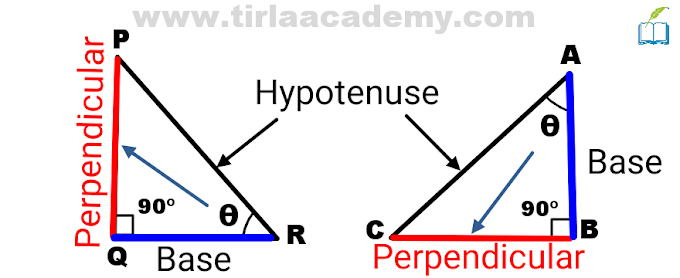How to find the height of a tower for unknown angles?
For better understanding take an example. Let's discuss-
Q-1) The angle of elevation of the top of a tower from two points at a distance of 4m & 9m from the base of the tower & in the same straight line with it are complementary. Find the height of the tower.
Solve:-
Let D & B are the points which are 4m & 9m away from the base of the tower (Point C).
According to the question, Angle making by point B & D to point A are complements to each other.
Sum of complementary angles is 90º.
Given: BC = 9m, DC = 4m
Let∠ABD = θ, So ∠ADC = (90º-θ)
In ∆ABC
tanθ = AC / BC { tan = Perpendicular / Base }
tanθ = AC / 9 .......Eq.1
In ∆ADC
tan(90ºθ) = AC / DC
cotθ = AC / 4 { cotθ= tan(90º-θ) }
1/tanθ = AC / 4 { cotθ = 1/tanθ }
tanθ = 4 / AC ......Eq.2
On equating values of Eq.1 & Eq.2
AC/9 = 4/AC
AC² = 9×4
AC² = 36
AC = √36
AC = 6
So the height of the tower will be 6m.
How to find the height of a tower if it is placed on the building?
Let's discuss
Q-2) From a point on the ground, the angle of elevation of the bottom & top of a transmission tower fixed at the top of a 20m high building is 45º & 60º respectively. Find the height of the tower.
Solve:-
Let DB = Height of building (20m)
AD = Height of Tower,
Point C makes an angle of 45º with D (Bottom of the tower).
& Point C makes an angle of 60º with point A (Top of the tower).
In ∆ABC
tan 60º = AB / BC { Value of tan60º = √(3) }
√3 = (AD + DB) / BC { AB = AD + DB }
√3 = (AD + 20) / BC .......Eq.1
In ∆DBC
tan45º = DB / BC { Value of tan45º = 1 }
1 = 20 / BC
BC×1 = 20
BC = 20m ........Eq.2
Put the value of BC in Eq.1
√3 = (AD + 20) / 20
20√3 = AD + 20
20√3 - 20 = AD
20(√3 - 1) = AD
We get the height of tower 20(√3 -1)m.








